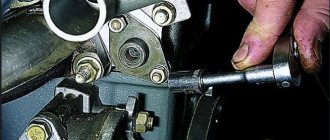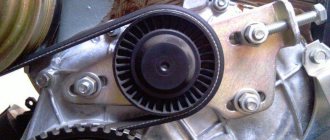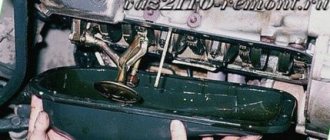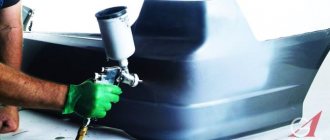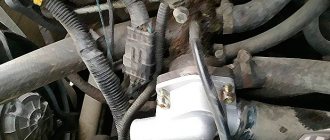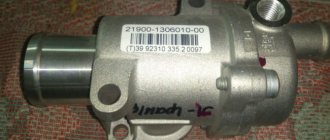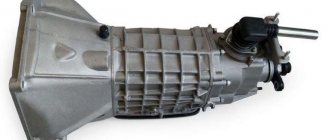What is a thermostat for?
The thermostat is necessary to maintain the coolant temperature within the operating range. In simple words, a thermostat is a valve that shuts off and opens the flow of coolant through the cooling radiator.
The operating temperature of the engine is from 80 to 95 degrees, this temperature is considered normal, and a working thermostat maintains exactly this coolant temperature. When the thermocouple is faulty, the temperature becomes less or much more than expected, which can even lead to engine failure.
Which manufacturers of thermostats for Chevrolet Niva should you trust and how to replace them yourself?
Thermostat is a device in the engine cooling system that automatically regulates the temperature of the coolant.
The device maintains optimal thermal operating conditions of the engine; with its help, the engine warms up faster.
Structurally, it is a valve, inside of which there is a heat-sensitive element that blocks the flow of water, antifreeze, antifreeze through the radiator until the engine is completely warmed up.
Installation location: in Chevrolet Niva it is located on the left front edge of the engine, connecting the lower pipe of the stove, pipes from the radiator, engine and throttle valve.
Symptoms of a problem
You can judge whether the thermostat is malfunctioning by finding signs of a malfunction in your car, such as insufficient coolant temperature, that is, when driving on the highway or in the cold season, the antifreeze temperature begins to drop rapidly or does not rise to operating temperature at all.
- The engine does not heat up to operating temperature;
- The engine overheats and constantly boils;
- Insufficient heating of the internal combustion engine during the cold season (cold air blows from the stove);
It should be noted that if the engine overheats, the reason may be not only the thermostat, but also the breakdown of the water pump blades.
Types of radiators for the Niva stove
It doesn’t immediately become colder in the Niva’s cabin – the stove stops working normally for several reasons:
- the heating tap does not switch (stays sour in the closed or half-closed position);
- The motor rotates at low speed;
- the heater radiator is clogged;
- an air lock is created in the cooling system;
- parts turn out to be defective;
- the valve in the thermostat opens prematurely;
- poor circulation is created in the cooling system due to the water pump.
It may still be cold inside the car due to a blown cylinder head gasket in the engine. To make the interior warmer, car owners often install on Niva 21213 cars:
- three-row copper radiators of the stove, they have better heat transfer;
- The heater motor is 2108, they are more efficient than the standard ones on the Niva.
RP for the VAZ 21213 is produced by various companies, and the quality of stove radiators may vary. On the auto parts market you mainly find parts from manufacturers:
- "Orenburg radiator";
- luzar;
- DAAZ;
- SHAAZ;
- "Likhoslavl Radiator Plant";
- Iran;
Based on the material used, RPs can be made of copper or aluminum, each of them has its own advantages and disadvantages. Aluminum radiator:
- heats up quickly;
- cheaper than copper;
- has high rigidity and low weight.
But aluminum RP is not repairable, it is practically impossible to solder it. Other disadvantages of aluminum include:
- rapid cooling, this metal does not retain heat well;
- susceptibility to corrosion, which is why aluminum RPs fail more often than copper ones.
The main disadvantage of copper RP is that it takes a long time to heat up the interior, but even after stopping the engine it retains heat for quite a long time
Copper heater radiators are approximately 30-50% more expensive than aluminum ones, but this is not so important - in general, the parts are still relatively inexpensive. The problem with copper RPs is different - the quality of the products is low, and it is not so easy to buy parts of acceptable quality.
Chevy Niva car owners often have problems with heating the interior; the car can be cold even in frosty temperatures of -15ºC - the aluminum radiator of the stove does not heat very well. Another problem on VAZ 2123 cars is that stove radiators often leak.
Aluminum heater radiators on a Niva car are inexpensive:
- VAZ-2123 (Chevrolet Niva) - on average from 700 to 1000 rubles;
- VAZ-21213 (21214/2105) - from 650 to 1100 rubles.
Copper RPs are sold more expensive, their prices range from 1,500 to 2,500 rubles, the cost depends on the brand of the product, the region of sales and the sellers themselves.
This is interesting: Tightening torques for threaded connections of the Chevrolet Lacetti engine management system 2004 - 2013
Examination
The check can be done without removing the part from the car. To do this, start the cold engine and wait until it warms up to operating temperature. During warming up, we touch the lower radiator pipe several times and evaluate its temperature. Before the car reaches operating temperature, the lower pipe must be cold; if it warms up at the same rate as the other pipes, then the thermostat is faulty and is stuck in the open position.
Operating principle
When the driver turns the key in the ignition switch, the contacts close, passing through the starter relay. The Chevrolet Niva and its engine are still switched off. Power is supplied to the holding and traction windings. The magnetic field in them with a certain force pulls the armature into the housing, thereby compressing the return spring.
After this, the anchor pushes the rod and contact plate. It closes the contacts on the solenoid relay. The electric starter motor begins to spin. At the same time, the armature fork extends the starter bendix (Niva Chevrolet 1600 is also equipped with it). There is a gear installed on the bendix. It engages with the flywheel on the car engine.
When the flywheel rotates faster than the starter and Bendix gear, the overrunning clutch comes into play. It prevents the torque from being transmitted to the bendix and then moves back with the help of a lever. And due to the return spring, the part goes back to its original position when the engine starts.
Types of thermostats
The standard Niva thermostat is a fairly reliable element and serves faithfully for a very long time. The opening temperature of the factory thermoelement is 85⁰С, which is not enough for the stove to operate efficiently in cold weather. There are a huge number of analogues of the factory thermostat, and one of them is a thermocouple with a large circle opening temperature of 92⁰C, which will allow the internal combustion engine to operate at higher temperature conditions and will make the interior heater work much more efficiently, which will not affect the operation of the internal combustion engine.
Why does the thermostat fail?
Failure is possible due to long-term use of coolant without replacing it. Since during heating and cooling, various chemical reactions occur inside the system, which cause both corrosion and various precipitation. The resulting debris passes through the thermostat, causing corrosion and contamination on it, causing it to jam.
It is recommended to change the coolant at least once every 3 years.
The main elements of the system and what are the benefits of silicone pipes
The details of the system are presented in the diagram above, these include:
- air cooling radiator (art. 2123-1301012);
- casing with fans (art. 2123-1300025-01);
- temperature sensor (art. 2101-3808600-02 and 2112-3851010);
- water pump (art. 2123-1307010);
- thermostat (art. 2123-1306010);
- pump (art. 21230-1307011-82).
All elements of the cooling system are connected to each other through various hoses and pipes, which in most cases are made of rubber or polymers with similar properties.
Note: the material used depends solely on the manufacturer of the specific spare part, so when choosing, you should pay attention to this point.
As a reasonable alternative to rubber hoses, car enthusiasts increasingly prefer silicone analogues, which are significantly more expensive. The main reason for this is that silicone does not “tan” in the cold and does not crack. This prevents coolant from leaking out of the system, which greatly affects its performance. Complete set of Chevrolet Niva cooling system pipes:
- Upper radiator hose - 1 piece;
- Lower radiator hose - 1 piece;
- Thermostat and water pump pipe 1 piece;
- Heater radiator supply hose;
- Heater radiator outlet hose.
The strength of the silicone itself largely depends on the thickness of the tube walls, as well as the presence of special reinforcement. Parts made from this material, made specifically for cooling systems, are often characterized by double reinforcement, which makes their design much stronger and more durable.
If you believe the reviews of the Shniva owners themselves, then all the additional costs of replacing rubber cooling pipes with silicone ones are completely justified. This is especially true if the car is operated in harsh northern conditions.
It should also be noted that in most cases the connections are clamped with spring clamps and only in rare cases are screw clamps used. Another undoubted advantage of silicone is the fact that it resists the effects of gasoline well without changing its physical properties.
Replacement
To replace the thermostat on a Niva, it is necessary to drain the coolant, so it is recommended to carry out work on a cool engine to avoid burns.
Lick the coolant from the radiator cap.
We unscrew the hoses that go to the thermostat and assess their condition; if the pipes are severely dented or have cracks, they need to be replaced. It’s the same with clamps; rusty clamps need to be replaced.
We install the new thermostat in reverse order.
As you can see, replacing the thermostat on a Niva does not cause any difficulties.
The final stage of work
The tubes are mounted in the reverse order, the clamps are attached, and the expansion tank bolt is screwed on. The barrel is filled with antifreeze and after several days of operating the machine, the liquid level in the tank is monitored. The absence of smudges, odor and warm comfort in the cabin will be a reason to replace the glove box.
1. Open the lid to relieve pressure in the cooling system. Unscrew the cooling hose from the throttle body. Instead, we put on a hose, the other end of the hose into a 5-liter bottle or whatever is at hand. We plug the removed cooling hose with a finger and blow into the tank, blowing out some of the antifreeze or antifreeze from the system, whoever drives what.
2. Remove the glove compartment.
3. Unscrew the air duct on the legs, which will get in the way when pulling out the stove, everything is simple, just one screw.
4. You can drill a hole in the stove to drain some of the remaining liquid, so that when we remove the pipes, it won’t leak from them. I drilled a hole and pressed the edge of a rubber hose against it, draining the remainder into a bottle.
5. Unscrew the hose clamps wider and move the clamps as close to the body as possible so as not to interfere. It is more convenient to remove the hoses when pulling out the stove.
6. It may be necessary to break off the edge of the stove. This can be done with wire cutters. While only one car required such an operation, the stove was pulled out like this.
7. On the new stove, we cut off the edge as in the photo, this is in case when pulling it out it was not possible to remove it without breaking off the corner.
8. We install the stove, put on the hoses, remembering the kind words of the designers.
9. Seal the hole that appears with sealant. I usually use Abro Gray 999, it’s thick and doesn’t stink.
Well, then we collect everything as it was.
Removal of the heater radiator for the interior of a Niva Chevrolet car is carried out in the event of a violation of its tightness, as evidenced by the presence of smudges and the characteristic smell of coolant in the car interior. The radiator is also removed when carrying out other work in which its presence will interfere with the progress of the work. Prepare a standard set of tools and perform the following sequence of actions:
- First of all, we dismantle the glove box.
- Next, unscrew the screws and remove the decorative trim of the windshield.
- Then drain the liquid from the cooling system.
- Remove the outside air supply filter element.
- Then use a Phillips screwdriver to unscrew the screws securing the filter housing.
- Next, unscrew the screws securing the radiator housing.
- And unscrew the screws securing the heater mounting bracket.
- We remove the air duct for heating the feet of the passenger and driver.
- Bend the heater mounting bracket a little to the side.
- By bending the bracket, we remove the intermediate air duct from its seat.
- Now unscrew the radiator mounting screws.
- We disconnect the inlet and outlet hoses from the radiator by loosening their fastening clamps.
- And carefully remove the radiator from its case.
At this point, the repair work on removing the interior heater radiator on a Niva Chevrolet car has been completed. Make the necessary repairs, then install in the reverse order.
